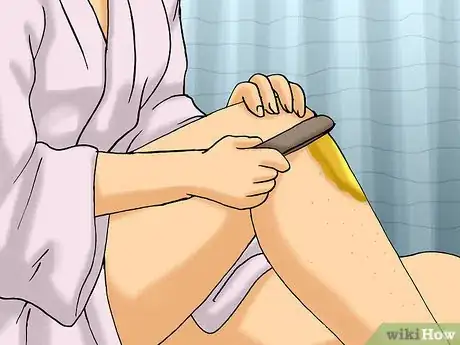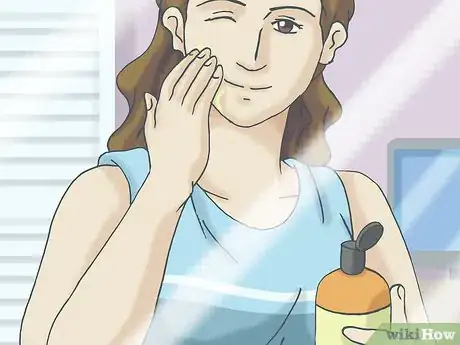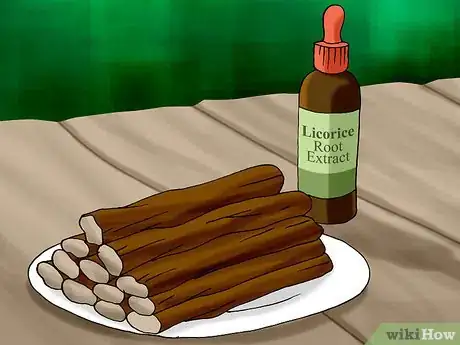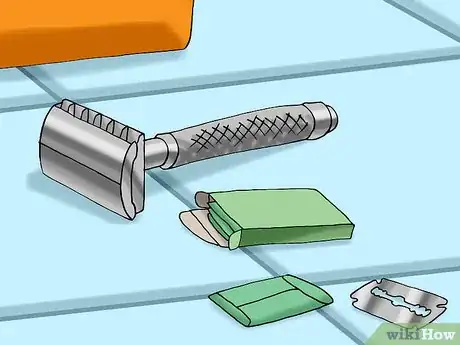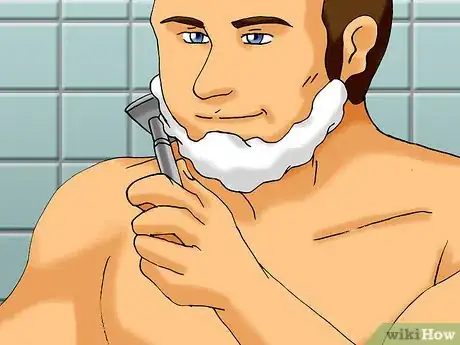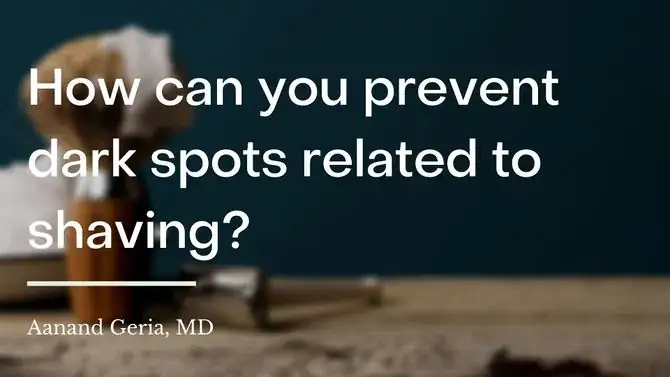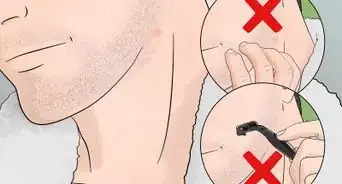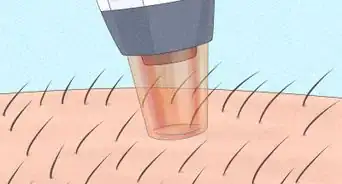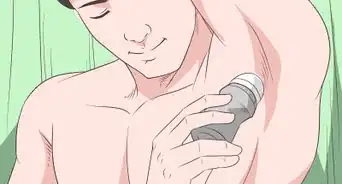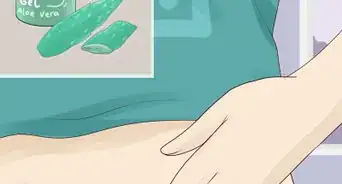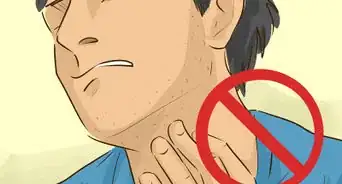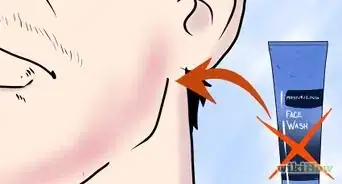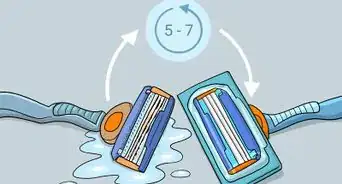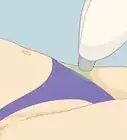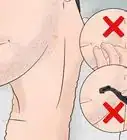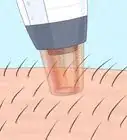This article was co-authored by Aanand Geria, MD. Dr. Aanand Geria is a board certified dermatologist, a clinical instructor at Mt. Sinai, and the owner of Geria Dermatology based in Rutherford, New Jersey. Dr. Geria's work has been featured in Allure, The Zoe Report, NewBeauty, and Fashionista, and he has peer-reviewed work for the Journal of Drugs in Dermatology, Cutis, and Seminars in Cutaneous Medicine and Surgery. He holds a BS from the Penn State University and an MD from Rutgers New Jersey Medical School. Dr. Geria then finished an internship at Lehigh Valley Health Network and a dermatology residency at the Howard University College of Medicine.
There are 9 references cited in this article, which can be found at the bottom of the page.
This article has been viewed 234,318 times.
Dark spots can result from either hyperpigmentation, hair follicles peeking through the surface of your skin, or clogged hair follicles and ingrown hairs. If you see dark hair follicles just under your skin after shaving, your best option is to try waxing or plucking. Darkened spots from hyperpigmentation (an excess of pigment, which gives skin color) usually go away on their own after a few months, but there are a few things you can try to help lighten the affected areas in a shorter amount of time. See a dermatologist if your dark spots persist despite the steps you’ve taken at home.
Steps
Home Remedies
-
1Try waxing or plucking. Dark spots after shaving can be caused by freshly shaved hair follicles peeking out from just under your skin. If your dark spots are due to subsurface hair, consider waxing or plucking the affected area to remove dark follicles.[1]
-
2Apply sunscreen every day. Be sure to apply a broad-spectrum sunscreen before going outside, especially if the affected area will be exposed to the sun. Choose a sunscreen with a sun protection factor (SPF) of 30 or higher. Unprotected exposure to sunlight will worsen your dark spots.[2]Advertisement
-
3Use a vitamin C serum to fade spots. An over-the-counter vitamin C serum can lighten dark spots without affecting the surrounding skin. Wash your skin, then rub a small amount of the serum in before you put on sunscreen.[3]
-
4Try a licorice root extract to lighten dark areas. Look for a ready-made licorice root extract skin salve that contains liquiritin. Applying a topical cream (1 gram per day) every day for a month can lighten dark spots.[4]
- It’s best to check with your doctor before trying licorice root and other herbal extracts, especially if have existing health conditions, such as diabetes. You should avoid using licorice root if you’re pregnant or plan on getting pregnant.[5]
- Licorice root is believed to have anti-inflammatory properties and can help ease skin problems.
Prevention
-
1Wet your skin before shaving. Don't shave dry skin! Water softens your skin and hair, making shaving easier. Wash your skin, or at least get it wet, before picking up the razor.[6]
-
2Apply shave gel. Use a gel or cream when you're shaving. Pick a product that's targeted for sensitive skin if necessary.[7]
- It is easier to shave raised hairs and moisturized skin. Your razor will be less likely to cause irritation or ingrown hairs as a result.
-
3Use a sharp razor. Avoid shaving with dull blades. Swap out disposable razors or change the blade after using your razor 5-7 times.[8]
-
4Shave gently in the direction of hair growth. No matter where you’re shaving, always go in the direction that your hair grows. Shaving against the grain pulls at the hair, which can cause ingrown hair and razor burn or bumps.[9]
- Rinse the razor with hot water after every stroke to prevent too much hair from collecting between the blades.
-
5
-
6Moisturize your skin after shaving. Once you're done shaving, gently pat your skin dry. Then apply a moisturizing lotion.[12]
Dermatology
-
1Get a referral to a dermatologist from your primary doctor. If your dark spots persist for several months and home solutions are ineffective, consider seeking a medical solution. Call your primary care doctor and ask them to recommend a dermatologist. You can also find a dermatologist by using the search tool on the website of the American Academy of Dermatology: https://find-a-derm.aad.org/
- Call your insurance provider to make sure any dermatological care you’ll need is covered. Ask them if specialist care needs prior approval and if they can provide you with in-network care providers.
-
2Discuss your skincare routines with your dermatologist. Tell your dermatologist about your shaving practices, skincare routine, and any products you use. That way, they can help you figure out the best treatment plan.
- You should also be prepared to discuss your diet, sun exposure and sunscreen use, and any over the counter whitening products you’ve used.
- If your job requires you to be clean-shaven in the workplace, but you suffer from severe razor bumps, consider asking your employer whether your dermatologist can sign a waiver that will exempt you from having to shave every day.[13]
-
3Rule out other medical causes. Even if you’re sure that your dark spots are the result of shaving, you should work with your doctor and dermatologist to rule out other causes. Hyperpigmentation can have a number of underlying issues.[14]
- Common causes of dark spots include ingrown hairs, minor and chronic bacterial infections, and hormonal and dietary imbalances. Your dermatologist will help you understand the best steps to take, whether it’s switching up your shaving routine or changing your diet.
- Be sure to discuss any existing medical conditions, as they’ll help your dermatologist choose the best course of action.
-
4Ask your dermatologist about treatment options. Your dermatologist might prescribe a lightening cream or suggest a skin treatment that uses lasers or light therapy.[15] Your dermatologist might also recommend a chemical peel, but keep in mind that you may want to schedule this when you're able to stay home for 2-3 days, as you may experience peeling for a couple of days after the procedure.
- These medications and procedures are often classified as cosmetic, so they may not be covered under your insurance and can be very expensive.
Expert Q&A
Did you know you can get expert answers for this article?
Unlock expert answers by supporting wikiHow
-
QuestionHow can you prevent dark spots related to shaving?
 Aanand Geria, MDDr. Aanand Geria is a board certified dermatologist, a clinical instructor at Mt. Sinai, and the owner of Geria Dermatology based in Rutherford, New Jersey. Dr. Geria's work has been featured in Allure, The Zoe Report, NewBeauty, and Fashionista, and he has peer-reviewed work for the Journal of Drugs in Dermatology, Cutis, and Seminars in Cutaneous Medicine and Surgery. He holds a BS from the Penn State University and an MD from Rutgers New Jersey Medical School. Dr. Geria then finished an internship at Lehigh Valley Health Network and a dermatology residency at the Howard University College of Medicine.
Aanand Geria, MDDr. Aanand Geria is a board certified dermatologist, a clinical instructor at Mt. Sinai, and the owner of Geria Dermatology based in Rutherford, New Jersey. Dr. Geria's work has been featured in Allure, The Zoe Report, NewBeauty, and Fashionista, and he has peer-reviewed work for the Journal of Drugs in Dermatology, Cutis, and Seminars in Cutaneous Medicine and Surgery. He holds a BS from the Penn State University and an MD from Rutgers New Jersey Medical School. Dr. Geria then finished an internship at Lehigh Valley Health Network and a dermatology residency at the Howard University College of Medicine.
Board Certified Dermatologist
-
QuestionShould I shave up or down?
 Aanand Geria, MDDr. Aanand Geria is a board certified dermatologist, a clinical instructor at Mt. Sinai, and the owner of Geria Dermatology based in Rutherford, New Jersey. Dr. Geria's work has been featured in Allure, The Zoe Report, NewBeauty, and Fashionista, and he has peer-reviewed work for the Journal of Drugs in Dermatology, Cutis, and Seminars in Cutaneous Medicine and Surgery. He holds a BS from the Penn State University and an MD from Rutgers New Jersey Medical School. Dr. Geria then finished an internship at Lehigh Valley Health Network and a dermatology residency at the Howard University College of Medicine.
Aanand Geria, MDDr. Aanand Geria is a board certified dermatologist, a clinical instructor at Mt. Sinai, and the owner of Geria Dermatology based in Rutherford, New Jersey. Dr. Geria's work has been featured in Allure, The Zoe Report, NewBeauty, and Fashionista, and he has peer-reviewed work for the Journal of Drugs in Dermatology, Cutis, and Seminars in Cutaneous Medicine and Surgery. He holds a BS from the Penn State University and an MD from Rutgers New Jersey Medical School. Dr. Geria then finished an internship at Lehigh Valley Health Network and a dermatology residency at the Howard University College of Medicine.
Board Certified Dermatologist
-
QuestionHow do you prevent dark spots after shaving?
 Aanand Geria, MDDr. Aanand Geria is a board certified dermatologist, a clinical instructor at Mt. Sinai, and the owner of Geria Dermatology based in Rutherford, New Jersey. Dr. Geria's work has been featured in Allure, The Zoe Report, NewBeauty, and Fashionista, and he has peer-reviewed work for the Journal of Drugs in Dermatology, Cutis, and Seminars in Cutaneous Medicine and Surgery. He holds a BS from the Penn State University and an MD from Rutgers New Jersey Medical School. Dr. Geria then finished an internship at Lehigh Valley Health Network and a dermatology residency at the Howard University College of Medicine.
Aanand Geria, MDDr. Aanand Geria is a board certified dermatologist, a clinical instructor at Mt. Sinai, and the owner of Geria Dermatology based in Rutherford, New Jersey. Dr. Geria's work has been featured in Allure, The Zoe Report, NewBeauty, and Fashionista, and he has peer-reviewed work for the Journal of Drugs in Dermatology, Cutis, and Seminars in Cutaneous Medicine and Surgery. He holds a BS from the Penn State University and an MD from Rutgers New Jersey Medical School. Dr. Geria then finished an internship at Lehigh Valley Health Network and a dermatology residency at the Howard University College of Medicine.
Board Certified Dermatologist It's usually a good idea to switch to an electric trimmer, and if you're able to, leave a little bit of stubble instead of shaving all the way down to your skin. If you have to be clean-shaven for work but you get really bad razor bumps, you may be able to get a waiver from your dermatologist, since that's a medical reason not to shave.
It's usually a good idea to switch to an electric trimmer, and if you're able to, leave a little bit of stubble instead of shaving all the way down to your skin. If you have to be clean-shaven for work but you get really bad razor bumps, you may be able to get a waiver from your dermatologist, since that's a medical reason not to shave.
References
- ↑ http://thebeautybrains.com/2006/12/the-top-5-causes-of-darkened-armpits/
- ↑ https://www.ncbi.nlm.nih.gov/pmc/articles/PMC2921758/
- ↑ https://www.self.com/story/dark-spot-treatments
- ↑ https://www.ncbi.nlm.nih.gov/pmc/articles/PMC2921758/
- ↑ https://nccih.nih.gov/health/licoriceroot
- ↑ https://www.aad.org/public/everyday-care/skin-care-basics/hair/how-to-shave
- ↑ https://www.aad.org/public/everyday-care/skin-care-basics/hair/how-to-shave
- ↑ https://www.aad.org/public/everyday-care/skin-care-basics/hair/how-to-shave
- ↑ https://www.aad.org/public/everyday-care/skin-care-basics/hair/how-to-shave
- ↑ https://share.upmc.com/2018/11/how-to-get-rid-of-razor-bumps/
- ↑ https://www.aad.org/public/everyday-care/skin-care-basics/hair/how-to-shave
- ↑ https://www.nationwidechildrens.org/conditions/folliculitis
- ↑ Aanand Geria, MD. Board Certified Dermatologist. Expert Interview. 8 July 2020.
- ↑ https://www.ncbi.nlm.nih.gov/pmc/articles/PMC2921758/
- ↑ https://dermnetnz.org/topics/postinflammatory-hyperpigmentation/
About This Article
To remove dark spots after you’re done shaving, try waxing or plucking the affected area to get rid of hair follicles under your skin. Before you go outside, apply sunscreen to the dark patch, which will prevent the sun from making the spots worse. If you want to gently bleach your spots, dab some lemon juice onto the area with a cotton swab. Alternatively, put on a vitamin C whitening cream, which you can purchase from the drug store. You can also apply some aloe vera gel to your spots, and rinse it off after 30 minutes. Do this twice a day for the best results. If you don't see any improvement from these home remedies after several months, ask a dermatologist about prescription treatments, like hydroquinone. For tips on how to prevent dark spots when you’re shaving, keep reading!
